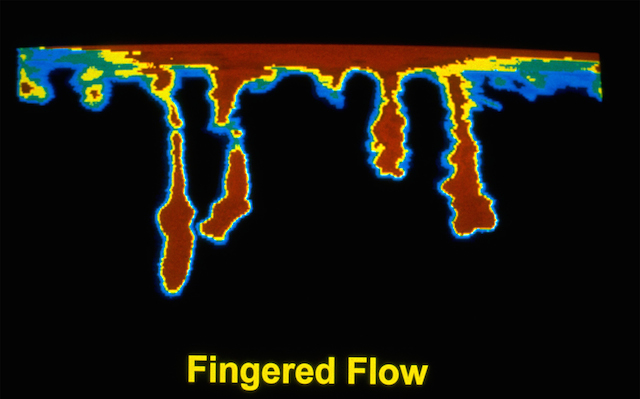Water is central to everything that happens in turf management. However, water is an inherently finite resource and its use in the turf industry is coming under increased scrutiny in parts of the western United States. In California, for example, sports turf managers are being mandated to reduce water use by as much as 25% in the face of continuing severe drought conditions.
As you know, too much or too little can water can significantly alter playing surfaces, complicating a turf manager’s already tough job and putting athletes at increased risk for injury. So how do turf managers balance the need for a uniform, safe playing surface against a mandate to use less water? Wetting agents (or soil surfactants) can help.
Improve irrigation efficiency
To understand how wetting agents work, we first have to understand what happens when water is applied to a playing surface. It is our natural inclination to think that water applied on the surface will penetrate uniformly and without issue. However, the study of soil science has shown that this is not always the case. Over time, all soils develop water repellency to some degree. Water repellent coatings form on soil particles from root exudates, fungal hyphae, and decomposing organic matter—all byproducts of growing healthy plants. These water repellent coatings on soil particles act as a barrier, making it harder for water to penetrate and move through soil evenly.
In highly managed turfgrass environments such as sports fields, water repellency tends to be more severe at the surface and declines farther along the soil profile. Typically, the top 3 centimeters of a coarse textured soil are the most hydrophobic. This top 3 cm is enough to significantly disrupt water movement. Water repellency at the surface is evident when runoff, puddling, and/or slow infiltration occur.
Water repellency significantly reduces irrigation distribution uniformity. Although not visually evident, the delay in water movement into the soil in an arid environment also causes water loss to evaporation. This water repellency and loss prevents turf from getting the water it needs to survive. It also contributes to wasted water and run-off of soil directed chemicals such as fertilizer and pesticides.
Water repellency is at work below the surface as well. Untreated water repellency disrupts uniform downward water movement, causing it to channel unevenly through the profile, sometimes referred to as “fingered flow.” Again, this leaves some areas of the soil too wet and others too dry, which prevents uniform root establishment and turf growth.
A proven wetting agent program will improve the relationship between water and soil, resulting in more uniform soil moisture, improved turf quality, and safer playing conditions no matter how much (or how little) water is applied.
If you have ever had difficulty getting certain areas of a field to absorb water, or if specific areas are always quick to wilt, then you likely have issues with water repellency. Using a wetting agent will help to maintain soils at a consistent volumetric water content and improve distribution uniformity. Wetting agents encourage a “matrix flow” of water, distributing water and the important inputs it carries more evenly throughout the soil profile.
From both an environmental and economic standpoint, water is one of the most important components of turf maintenance plans and budgets. Wetting agents help water penetrate the soil surface and retain moisture in the soil profile. By doing so, less water is needed to maintain high quality turf, thus reducing both the environmental and financial costs associated with irrigating.
Even in areas where rainfall is abundant or where high efficiency irrigation systems are in place; wetting agents help to maximize water use efficiency by improving distribution uniformity and enhancing water movement through the soil profile. This reduces the amount of water needed during each irrigation cycle and can extend the amount of time between each irrigation event.
Which wetting agent is right for you?
It is important to note that not all wetting agents are the same. Non-ionics are the most common surfactants used in turfgrass management. Numerous surfactant chemistries exist and performance characteristics vary depending on chemical structure and the makeup of your soil.
So how do you know which wetting agent is right for you? Rely on data from universities in your geographical area. Local distributors should also be able to tell you the key components in each wetting agent product and how those ingredients work in the soil and at what rate phytotoxicity may occur.
As a turfgrass manager your job is to maintain quality turf while being as efficient and cost-effective as possible. Water repellency can make your job more difficult, especially when drought conditions or water use restrictions come into play. Incorporating a wetting agent into your turf management program will decrease the amount of water lost to runoff and evaporation and improve turf quality. If you need assistance determining which wetting agent chemistry is right for you, discuss it with your local distributor or a wetting agent manufacturer. Most will be able to determine your specific issue and find a wetting agent solution that fits for local growing conditions.
Find a program that works and stick to it
The key to any successful wetting agent program is to start early and remain on a consistent application schedule. Although wetting agents can help turf recover from existing water repellency issues, instituting a proven program before the development of water repellency can provide a number of benefits.
By increasing soil moisture uniformity, wetting agents help to create a healthier and more consistent growing environment. If the growing environment is managed to its peak potential early in the season, turf will be healthier and better able to defend itself when stress and disease pressures kick in. In addition, water and monetary savings produced early in the season can be banked for the late summer months when the need for frequent irrigation becomes greater.
This article was supplied by Aquatrols.


